Torosaurus latus Marsh, 1891

(Da: fr.wikipedia.org)
Phylum: Chordata Haeckel, 1874
Subphylum: Vertebrata Cuvier, 1812
Classe: Dinosauria Owen, 1841
Ordine: Ornithischia Seeley, 1888
Famiglia: Ceratopsidae Marsh, 1890
Genere: Torosaurus Marsh, 1891
Descrizione
Fa parte della famiglia dei ceratopsidi, infatti aveva comportamenti analoghi al Triceratops (suo parente più prossimo) ed il suo cranio è caratterizzato da un collare osseo molto sviluppato in altezza ("a collare lungo") e da tre corna. Ad oggi l'esistenza della specie stessa è stata messa in discussione, data la possibilità che Torosaurus fosse semplicemente uno dei sessi di Triceratops, presentando caratteri da dimorfismo sessuale soprattutto per quando concerne la cresta osseo craniale.La sua testa raggiunge i 2.5 m di lunghezza ed è considerata la seconda più grande fra quelle di tutti gli animali terrestri estinti ed attualmente presenti. È stato uno degli ultimi dinosauri a comparire prima dell'estinzione del limite K-T. Quando il torosauro abbassava la massiccia testa, il magnifico collare osseo che la incorniciava si ergeva dando l'impressione di avere una mole maggiore di quella reale, capace, quindi, di scoraggiare attacchi di predatori anche di grossa taglia, come il Tyrannosaurus; in questo caso, alcuni scienziati hanno definito il torosauro come "una preda a carissimo prezzo". Con il collare ritto il torosauro poteva essere avvistato da notevole distanza. Questo dinosauro era più lungo di un elefante, 7.6 m di lunghezza, e pesava probabilmente tra le 6 e le 8 tonnellate. Si muoveva sulle quattro zampe massicce e si ritiene conducesse una dieta principalmente vegetariana. Il paleontologo John Horner ha ipotizzato che Torosaurus sia in realtà la forma anziana del genere Triceratops, e che quindi non sia più un genere valido.
Diffusione
Era un dinosauro quadrupede, erbivoro, vissuto durante il Maastrichtiano (tardo Cretaceo) nel Nordamerica, circa 70 milioni di anni fa.
Sinonimi
= Arrhinoceratops? utahensis Gilmore, 1946.
Bibliografia
–Hicks, J.F., Johnson, K.R., Obradovich, J. D., Miggins, D.P., and Tauxe, L. 2003. Magnetostratigraphyof Upper Cretaceous (Maastrichtian) to lower Eocene strata of the Denver Basin, Colorado. In K.R. Johnson, R.G. Raynolds and M.L. Reynolds (eds), Paleontology and Stratigraphy of Laramide Strata in the Denver Basin, Pt. II., Rocky Mountain Geology 38: 1-27.
–Paul, G.S.; Christiansen, P. (2000). "Forelimb posture in neoceratopsian dinosaurs: implications for gait and locomotion" (PDF). Paleobiology. 26 (3): 450-465.
–Paul, G. S. (2010). The Princeton Field Guide to Dinosaurs. Princeton University Press. pp. 265-267.
–Holtz, Thomas R. Jr. (2012). Dinosaurs: The Most Complete, Up-to-Date Encyclopedia for Dinosaur Lovers of All Ages (PDF). Winter 2011 Appendix.
–Longrich, N. R. & Field, D. J. (2012). "Torosaurus is not Triceratops: Ontogeny in chasmosaurine ceratopsids as a case study in dinosaur taxonomy". PLoS ONE. 7 (2): e32623.
–"Morph-osaurs: How shape-shifting dinosaurs deceived us – life – 28 July 2010". New Scientist.
–Scannella, J. and Horner, J.R. (2010). "Torosaurus Marsh, 1891, is Triceratops Marsh, 1889 (Ceratopsidae: Chasmosaurinae): synonymy through ontogeny ." Journal of Vertebrate Paleontology, 30(4): 1157-1168.
–Switek, Brian. "New Study Says Torosaurus=Triceratops". Dinosaur Tracking. Smithsonian.com. Archived from the original on November 13, 2013.
–Horner, Jack (November 2011). Shape-shifting Dinosaurs. TEDX Talks.
–Farke, Andrew A. (January 20, 2011). "Anatomy and Taxonomic Status of the Chasmosaurine Ceratopsid Nedoceratops hatcheri from the Upper Cretaceous Lance Formation of Wyoming, U.S.A".
–Maiorino L., Farke A.A., Kotsakis T., Piras P.,2013, "Is Torosaurus Triceratops? Geometric Morphometric Evidence of Late Maastrichtian Ceratopsid Dinosaurs", PLoS ONE 8(11): e81608.
–O.C. Marsh, 1891, "Notice of new vertebrate fossils", The American Journal of Science, series 3 42: 265-269.
–Dodson, P. The Horned Dinosaurs. Princeton Univ. Press (Princeton), 1996.
–Colbert, E.H. and J.D. Bump, 1947, "A skull of Torosaurus from South Dakota and a revision of the genus:, Proceedings of the Academy of Natural Sciences of Philadelphia, 99: 93-106.
–Farke, A., 2002, "A review of Torosaurus (Dinosauria: Ceratopsidae) specimens from Texas and New Mexico", Journal of Vertebrate Paleontology, 22: 52°.
–Lucas, S.G., Mack, G.H., Estep, G.W., 1998, "The Ceratopsian dinosaur Torosaurus from the Upper Cretaceous McRae Formation, Sierra County, New Mexico", New Mexico Geological Society Guidebook, 49th Field Conference, Las Cruces County II.
–C.W. Gilmore, 1946, "Reptilian fauna of the North Horn Formation of central Utah", United States Department of the Interior Geological Survey Professional Paper 210-C: 29-53.
–D.A. Lawson, 1976, "Tyrannosaurus and Torosaurus, Maestrichtian dinosaurs from Trans-Pecos, Texas", Journal of Paleontology 50(1): 158-164.
–Sullivan, R. M., A. C. Boere, and S. G. Lucas. 2005. Redescription of the ceratopsid dinosaur Torosaurus utahensis (Gilmore, 1946) and a revision of the genus. Journal of Paleontology 79: 564-582.
–Hunt, Rebecca K. and Thomas M. Lehman. 2008. Attributes of the ceratopsian dinosaur Torosaurus, and new material from the Javelina Formation (Maastrichtian) of Texas. Journal of Paleontology 82 (6): 1127-1138.
–Stein, Walter W. (2019). "TAKING COUNT: A Census of Dinosaur Fossils Recovered From the Hell Creek and Lance Formations (Maastrichtian)" (PDF). The Journal of Paleontological Sciences. 8: 1-42.
–Hatcher, J.B., Marsh O.C. and Lull, R.S., 1907, The Ceratopsia, Monographs of the United States Geological Survey 49: 1-198.
–Lull, R.S., 1933, A revision of the Ceratopsia or horned dinosaurs, Memoirs of the Peabody Museum of Natural History 3 (3): 1-175.
–Lehman, T.M., 1998, "A gigantic skull and skeleton of the horned dinosaur Pentaceratops sternbergi from New Mexico: Journal of Paleontology, 72 (5): 894-906.
–Nicholas R. Longrich, 2011, "Titanoceratops ouranous, a giant horned dinosaur from the Late Campanian of New Mexico", Cretaceous Research, 32: 264-276.
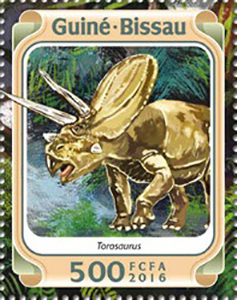
|
Data: 18/01/2016
Emissione: Dinosauri Stato: Guinea-Bissau Nota: Emesso in un foglietto di 6 v. diversi |
|---|
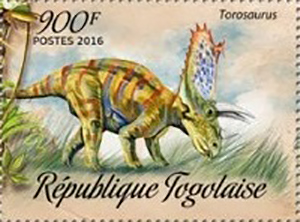
|
Data: 20/05/2016
Emissione: I dinosauri Stato: Togo Nota: Emesso in un foglietto di 4 v. diversi |
|---|
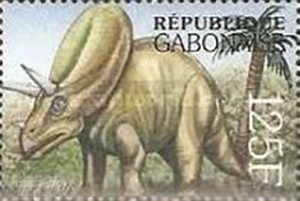
|
Data: 20/12/2000
Emissione: Fauna preistorica Stato: Gabon |
|---|
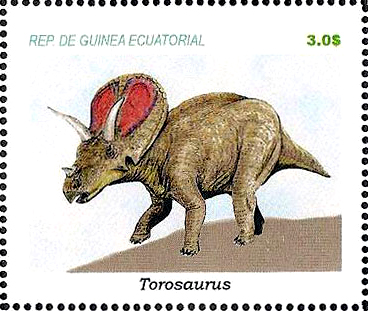
|
Data: 01/01/2009
Emissione: Animali preistorici Stato: Equatorial Guinea |
|---|
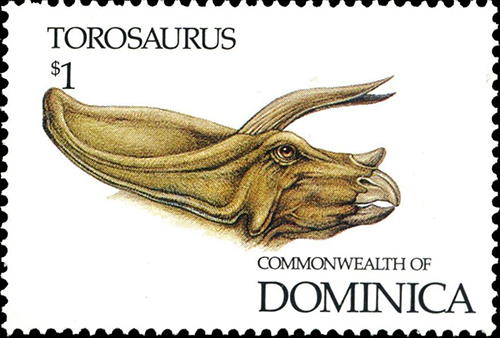
|
Data: 23/06/1992
Emissione: Dinosauri Stato: Commonwealth of Dominica |
|---|
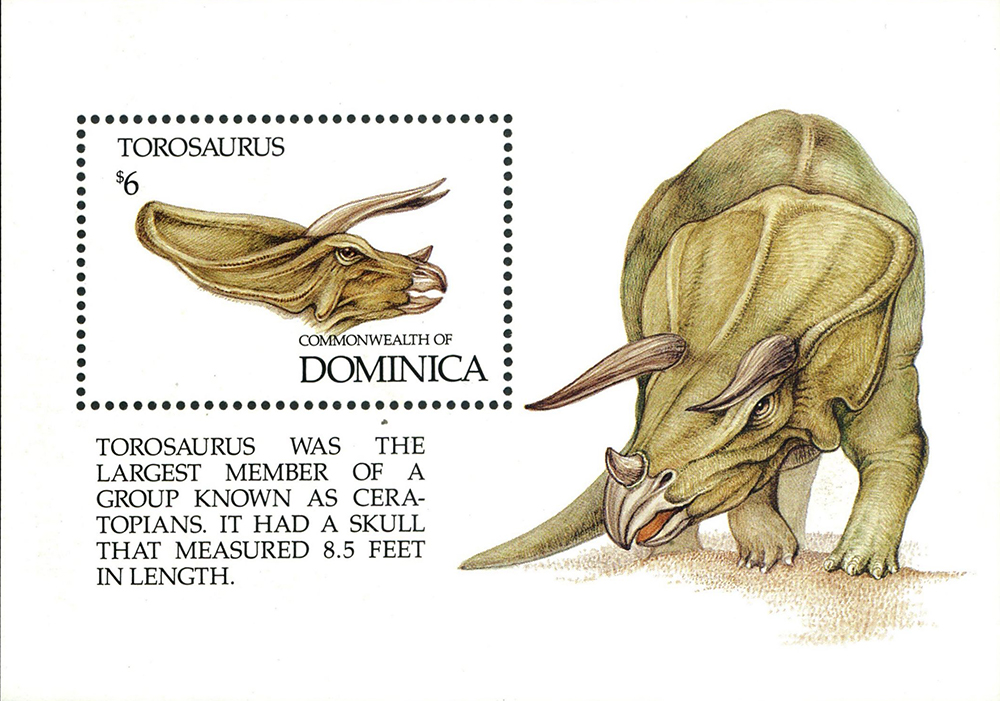
|
Data: 23/06/1992
Emissione: Dinosauri Stato: Commonwealth of Dominica |
|---|
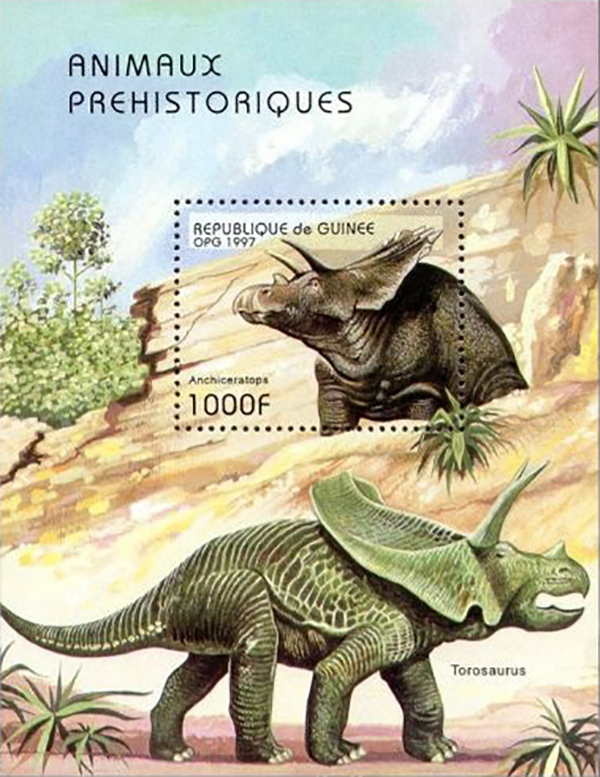
|
Data: 15/12/1997
Emissione: Fauna preistorica Stato: Guinea |
|---|
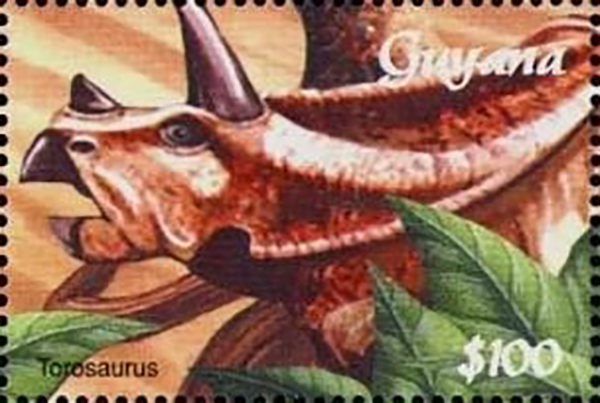
|
Data: 28/03/2001
Emissione: Creature preistoriche Stato: Guyana Nota: Emesso in un foglietto di 6 v. diversi |
|---|
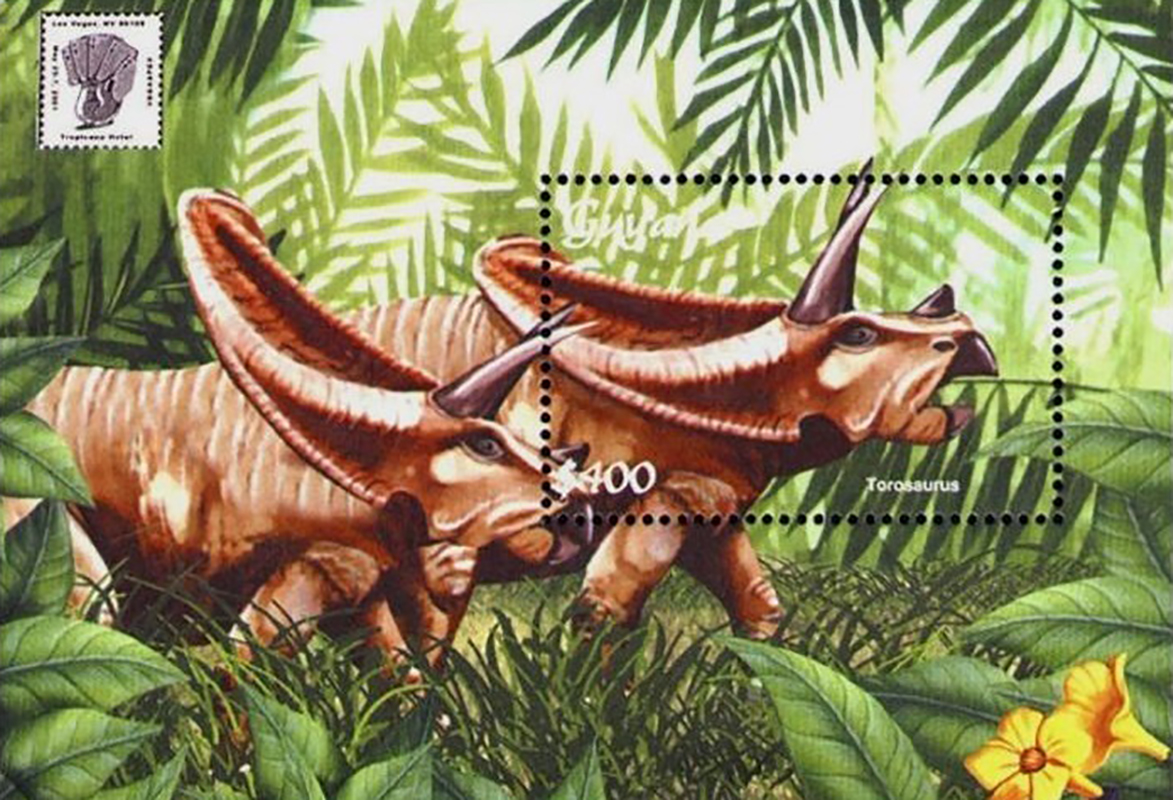
|
Data: 28/03/2001
Emissione: Creature preistoriche Stato: Guyana |
|---|
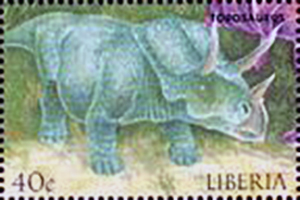
|
Data: 18/01/1999
Emissione: Animali preistorici Stato: Liberia Nota: Emesso in un foglietto di 8 v. diversi |
|---|
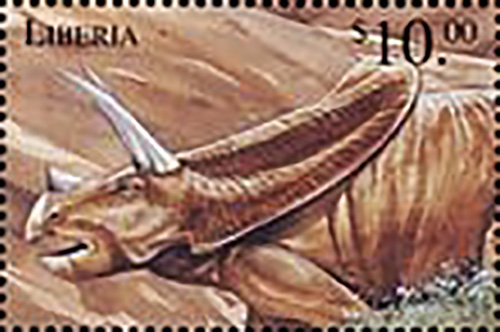
|
Data: 22/11/1999
Emissione: Animali preistorici Stato: Liberia |
|---|
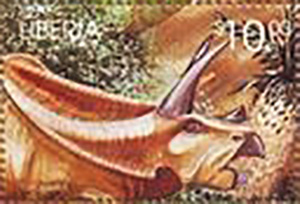
|
Data: 22/11/1999
Emissione: Animali preistorici Stato: Liberia |
|---|
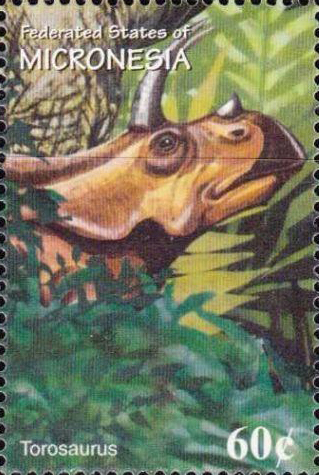
|
Data: 12/08/2001
Emissione: Dinosauri Stato: Micronesia Nota: Emesso in un foglietto di 6 v. diversi |
|---|
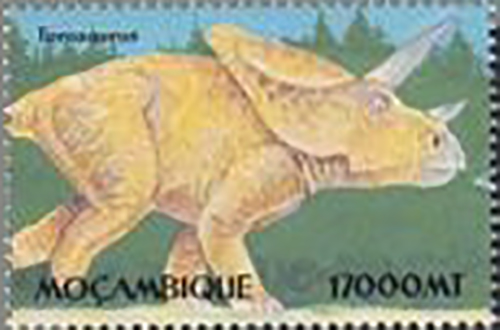
|
Data: 17/06/2002
Emissione: Animali preistorici Stato: Mozambique |
|---|
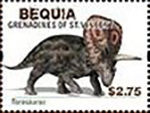
|
Data: 05/12/2012
Emissione: Dinosauri Stato: Bequia |
|---|
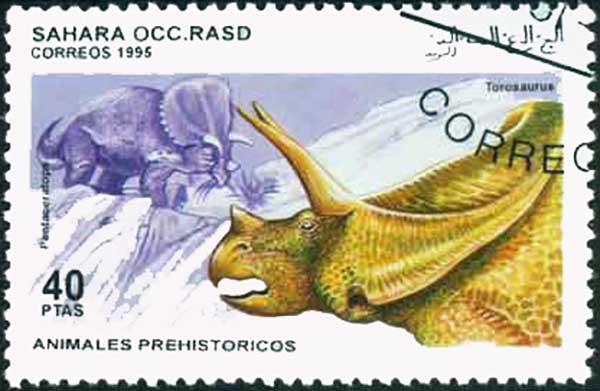
|
Data: 01/01/1995
Emissione: Animali preistorici Stato: Western Sahara |
|---|
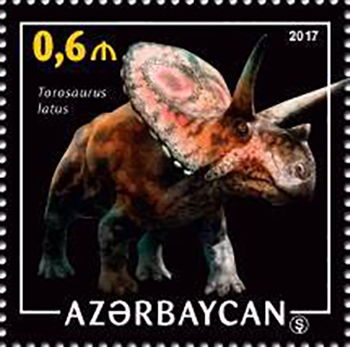
|
Data: 01/01/2017
Emissione: Animali preistorici Stato: Azerbaigian Nota: Emeso in un foglietto di 6 v. diversi |
|---|

|
Data: 24/04/2017
Emissione: I dinosauri Stato: Guinea Nota: Emesso in un foglietto di 4 v. diversi |
|---|
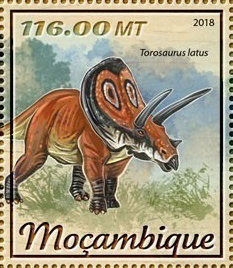
|
Data: 15/02/2018
Emissione: Dinosauri Stato: Mozambique Nota: Emesso in un foglietto di 4 v. diversi |
|---|
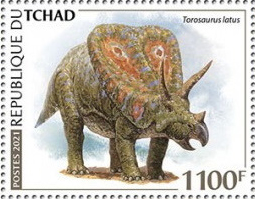
|
Data: 01/01/2021
Emissione: I dinosauri Stato: Chad Nota: Non ufficiale Emesso in un foglietto di 3 v. diversi |
|---|